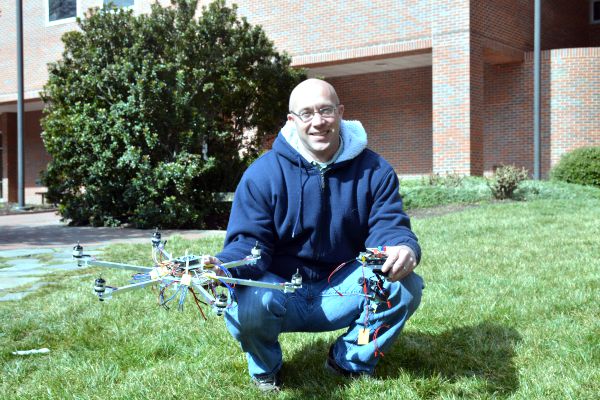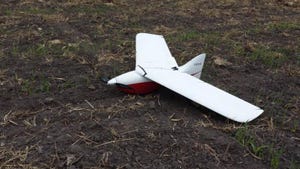
The Federal Aviation Administration gave North Carolina State University the green light in September to conduct research on using unmanned aerial vehicles, or UAVs, in agriculture.
The studies are now underway at the Vernon G. James Research and Extension Center in Plymouth.
The research, funded through the Golden Leaf Foundation, is being managed by N.C. State’s NextGen Air Transportation Center on the Centennial Campus in Raleigh. The vehicle currently being used in the research is a FourthWing Vireo, which is a fixed-wing system barely larger than a football. Later this year, they will fly a rotary system called the DJI Inspire.
The FAA granted NC State a Certificate of Authorization or COA to fly a UAV for research at Plymouth through the end of 2016, according to Rob Austin, a research specialist in the Soil Science Department at NC State University, who is conducting the research there.
“The COA is very specific,” Austin explained. “In addition to the many safety and operational details, it also tells you where you can fly, when you can fly and what aircraft you can use.”
Austin is using the UAV in a seven-acre wheat trial at Plymouth with an upcoming corn trial set to begin in April. Austin’s research is focusing on how different sensors mounted on a UAV can detect crops response to various nitrogen treatments.
“We are interested in capturing sets of still images with various UAV’s so we can mosaic them together and characterize spatial variability within an entire field area,” Austin said. “We will be using an off-the-shelf digital camera as well as a small multi-spectral camera to investigate nitrogen response at different wavelengths. The reason we do that is because plants use and respond to light differently at different wavelengths, particularly in the near-infrared. By looking at different wavelengths, it gives us a greater ability to identify properties related to crop health and nutrient status”.
Austin plans to fly at UAV every two weeks during peak growth stages to measure crop progress. Austin and his associates will put sensors on the UAVs which will allow them to take pictures throughout the growing season.
“We will look at the optical response measured by the sensors and relate that back to the different fertilizer treatments,” Austin explained. “We will acquire images throughout the season and perform additional measurements to validate and calibrate the same day we are flying.”
A key part of Austin’s research will be conducted on the ground, using tissue tests and a field spectrometer to validate the data received from the UAV by air. In addition, data collected by a Trimble GreenSeeker will be tested and compared to both the aerial and on-ground measurements, Austin explained.
“We really need that on-ground field data to validate what we see in the air,” Austin said. “The field data will tell us about the measured nutrient content in the plant at that particular stage. Without validating against actual ground data, it’s simply a number.”
The tissue tests will help validate the aerial UAV data, allowing researchers to quantify the data from the UAV sensors and identify fertility levels based on what the UAV sees, according to Austin.
“We plan to fly at multiple heights to get different ground resolutions and spatial extents,” Austin says. “Often with the other platforms, such as satellites or manned aircraft, your analysis is limited by ground resolution. With this type of system, you can control that. You can achieve really high ground resolution by flying at lower heights.”
At the end of the season, researchers will validate the UAV data with tissue test values to see how well different vegetative indices match what the crop has within it. “After analyzing the UAV imagery and on-ground measurements, we will look at how all of this relates back to yield,” Austin said.
FAA's proposed rule for micro UAVs
In the meantime, Austin welcomes the proposed draft rules for commercial use of small UAV’s that were announced by the FAA on Feb. 15. “They are common sense guidelines and pretty much what everyone expected,” he said. “They set a framework that people can work with and a pathway to move forward on commercial use.”
An additional key part of the regulations for agriculture is the FAA’s proposed rule for micro UAVs that weigh less than 4.4 pounds. “I suspect that these are the systems that a lot of crop scouts, ag agents and farmers would be interested in getting their hands on. They use a rotary platform that is easy to fly and enables you to perform spot inspections,” he said.
While N.C. State was given the go ahead to do research using UAVs, Austin believes widespread commercial use of the technology won’t get started until at least 2018. But he believes the technology will take off and offer farmers a new tool in precision agriculture in the truest sense of the word.
“UAVs offer real benefits over satellites and manned aircraft,” Austin said. “Because you’re flying so low to the ground, it gives you the ability to control ground resolution. The lower you fly, the greater the ground resolution. You can basically control the ground resolution based on your needs. It’s not a limiting factor like you sometimes run into with satellites or aircraft.”
UAVs will also offer farmers cost savings over satellite imagery and piloted aircraft, Austin said. “Farmers will be able to acquire higher resolution images at a lower cost,” he said. “For a couple of thousand dollars, you can get one of these systems up and running and gather data that is on par with these other systems at a much lower cost.”
Austin believes one of the most exciting benefits of UAVs is deployability or the timeliness of the technology. “The idea is that on any given day, a grower or crop scout can go out to the field, pull a UAV out of the bed of his pickup and fly it to capture timely information over his entire farm in a few hours is something we haven’t seen before,” Austin said.
For example, Austin said the goal is for famers to be be able to fly a UAV over their fields a day or two before they are thinking about applying nitrogen and be able make an actionable management decision based on what they see.
“It truly is precision agriculture, and I don’t see this complete set of capabilities with other technologies,” he said. “With satellites, you have concerns over resolution, cloud cover, return time and data access. And with aircraft, you have similar cloud cover and data access issues, plus the costs associated with an aircraft and pilot.”
UAVs offer timely information at higher resolutions thus constructing a truer sense of what is actually happening on the ground, Austin said.
“The hope is that this technology can make our farmers more efficient by providing information that supports their management decisions in a positive way,” Austin said.

NC State is using the Vireo, a unmanned aerial vehicle that is no larger than a football in its research at the Vernon G. James Research and Extension Center in Plymouth.
About the Author(s)
You May Also Like






